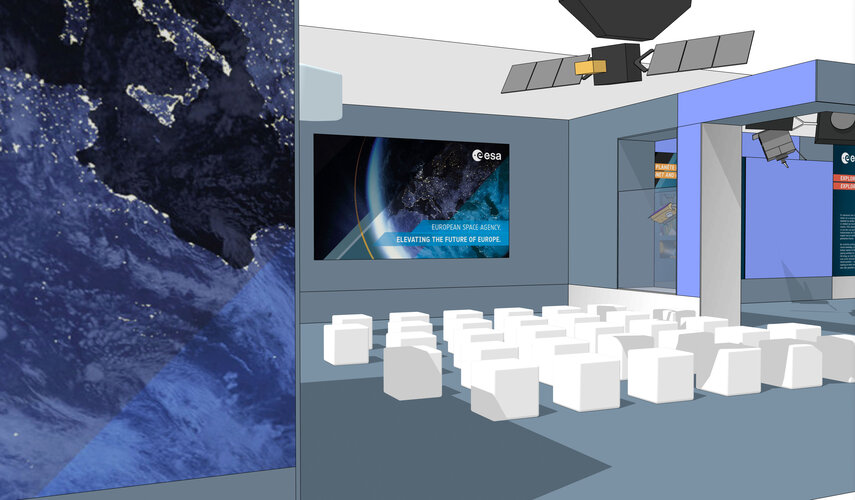Back to light
Monday, 12 May 2025 06:10
As the night closed in on Spain and Portugal on 28 April, polar satellites followed the blackout that lasted well into the early hours of the morning in several regions.
Save the date: 16–22 June - ESA at the Paris Air Show
Monday, 12 May 2025 05:50
The European Space Agency will be present at the 55th edition of International Paris Air Show, taking place on 16-22 June at Le Bourget airport.
Soviet-era spacecraft plunges to Earth after 53 years stuck in orbit
Sunday, 11 May 2025 10:23This request seems a bit unusual, so we need to confirm that you're human. Please press and hold the button until it turns completely green. Thank you for your cooperation!
Press and hold the button
If you believe this is an error, please contact our support team.
185.132.36.159 : 1858e1d4-b2de-4dc4-9f7d-2cab3d7a
Rocket Lab Secures U.S. Air Force Contract for Neutron Re-Entry Mission
Sunday, 11 May 2025 09:12 Rocket Lab USA, Inc. (Nasdaq: RKLB) has announced that it will launch its new medium-lift reusable rocket, Neutron, for the U.S. Air Force Research Laboratory (AFRL) as part of a pioneering Rocket Cargo mission. This mission, set for no earlier than 2026, will serve as a critical step in developing rapid, point-to-point cargo transportation capabilities, aiming to bolster global defense logistic
Rocket Lab USA, Inc. (Nasdaq: RKLB) has announced that it will launch its new medium-lift reusable rocket, Neutron, for the U.S. Air Force Research Laboratory (AFRL) as part of a pioneering Rocket Cargo mission. This mission, set for no earlier than 2026, will serve as a critical step in developing rapid, point-to-point cargo transportation capabilities, aiming to bolster global defense logistic Martian Seismic Data Suggests Potential Liquid Water Reserves at Depth
Sunday, 11 May 2025 09:12 Liquid water, a critical component for the habitability of Mars, may still be present beneath its surface, according to a recent study conducted by an international team of geophysicists and geologists. The research, led by Dr. Weijia Sun from the Institute of Geology and Geophysics, Chinese Academy of Sciences, alongside Dr. Hrvoje Tkalcic of The Australian National University, Dr. Marco G. Mal
Liquid water, a critical component for the habitability of Mars, may still be present beneath its surface, according to a recent study conducted by an international team of geophysicists and geologists. The research, led by Dr. Weijia Sun from the Institute of Geology and Geophysics, Chinese Academy of Sciences, alongside Dr. Hrvoje Tkalcic of The Australian National University, Dr. Marco G. Mal Oracle-M Completes Successful Hot Fire Test for Cislunar Space Mission
Sunday, 11 May 2025 09:12 The United States Space Force (USSF) Space Systems Command (SSC) and the Air Force Research Laboratory (AFRL) have achieved a critical milestone in cislunar space situational awareness (SSA) with the successful completion of the Oracle-M (Oracle-Mobility) Hot Fire Test at Edwards Air Force Base, California. Conducted from March 16 to 21, 2025, this test represents a pivotal step in readying Orac
The United States Space Force (USSF) Space Systems Command (SSC) and the Air Force Research Laboratory (AFRL) have achieved a critical milestone in cislunar space situational awareness (SSA) with the successful completion of the Oracle-M (Oracle-Mobility) Hot Fire Test at Edwards Air Force Base, California. Conducted from March 16 to 21, 2025, this test represents a pivotal step in readying Orac Simpler Quantum Information Processing Achieved Using Photon Time Encoding
Sunday, 11 May 2025 09:12 A team of researchers from Griffith University has introduced a new technique that significantly simplifies the use of high-dimensional quantum information encoded in light, potentially advancing next-generation quantum technologies.
This breakthrough, detailed in the journal Physical Review Letters, leverages a quantum effect known as Hong-Ou-Mandel (HOM) interference to streamline the de
A team of researchers from Griffith University has introduced a new technique that significantly simplifies the use of high-dimensional quantum information encoded in light, potentially advancing next-generation quantum technologies.
This breakthrough, detailed in the journal Physical Review Letters, leverages a quantum effect known as Hong-Ou-Mandel (HOM) interference to streamline the de Plato nears final camera installation for exoplanet hunt
Sunday, 11 May 2025 09:12 The assembly of the European Space Agency's (ESA) Plato mission is making significant strides, with 24 of the 26 planned cameras now integrated into the spacecraft. Once operational in space, Plato will utilize this extensive array of cameras to survey a vast portion of the sky in its search for terrestrial planets, aiming to uncover potentially habitable worlds.
Assembly work is progressi
The assembly of the European Space Agency's (ESA) Plato mission is making significant strides, with 24 of the 26 planned cameras now integrated into the spacecraft. Once operational in space, Plato will utilize this extensive array of cameras to survey a vast portion of the sky in its search for terrestrial planets, aiming to uncover potentially habitable worlds.
Assembly work is progressi Study reveals new source of the heavy elements
Sunday, 11 May 2025 09:12 Magnetar flares, colossal cosmic explosions, may be directly responsible for the creation and distribution of heavy elements across the universe, suggests a new study.
For decades, astronomers only had theories about where some of the heaviest elements in nature, like gold, uranium and platinum, come from. But by taking a fresh look at old archival data, researchers now estimate that up to
Magnetar flares, colossal cosmic explosions, may be directly responsible for the creation and distribution of heavy elements across the universe, suggests a new study.
For decades, astronomers only had theories about where some of the heaviest elements in nature, like gold, uranium and platinum, come from. But by taking a fresh look at old archival data, researchers now estimate that up to New UK Initiative to Revolutionize Solar Atmosphere Modelling
Sunday, 11 May 2025 09:12 A new GBP 5 million, five-year research initiative aims to tackle some of the most fundamental questions in solar physics, with a focus on the complex and dynamic processes occurring within the Sun's atmosphere. The Solar Atmospheric Modelling Suite (SAMS) project, funded by the Science and Technology Facilities Council's (STFC) new Large Award scheme, seeks to develop a next-generation modellin
A new GBP 5 million, five-year research initiative aims to tackle some of the most fundamental questions in solar physics, with a focus on the complex and dynamic processes occurring within the Sun's atmosphere. The Solar Atmospheric Modelling Suite (SAMS) project, funded by the Science and Technology Facilities Council's (STFC) new Large Award scheme, seeks to develop a next-generation modellin The Squid Galaxy's neutrino game just leveled up
Sunday, 11 May 2025 09:12 Buried deep in the ice in the Antarctic are "eyes" that can see elementary particles called neutrinos, and what they've observed is puzzling scientists: a remarkably strong neutrino signal accompanied by a surprisingly weak gamma-ray emission in the galaxy NGC 1068, also known as the Squid Galaxy.
The "eyes" are a collection of detectors buried in a cubic kilometer of ice called the IceCub
Buried deep in the ice in the Antarctic are "eyes" that can see elementary particles called neutrinos, and what they've observed is puzzling scientists: a remarkably strong neutrino signal accompanied by a surprisingly weak gamma-ray emission in the galaxy NGC 1068, also known as the Squid Galaxy.
The "eyes" are a collection of detectors buried in a cubic kilometer of ice called the IceCub Rheinmetall and ICEYE to Form Joint Venture for Satellite Production and Space Solutions
Sunday, 11 May 2025 09:12 Rheinmetall and leading SAR satellite manufacturer ICEYE have announced plans to form a joint venture dedicated to satellite production and advanced space solutions. This partnership, formalized through a memorandum of understanding signed on May 8, 2025, marks a significant step forward in the companies' collaborative efforts to expand their presence in the global space market.
Under the
Rheinmetall and leading SAR satellite manufacturer ICEYE have announced plans to form a joint venture dedicated to satellite production and advanced space solutions. This partnership, formalized through a memorandum of understanding signed on May 8, 2025, marks a significant step forward in the companies' collaborative efforts to expand their presence in the global space market.
Under the Sierra Space Reaches Key Milestone in Space Force R-GPS Program
Sunday, 11 May 2025 09:12 Sierra Space, a major player in commercial space and defense technology, has announced the successful completion of a critical testing phase for its Resilient GPS (R-GPS) technology, developed in collaboration with the U.S. Space Force (USSF). This third milestone marks a significant step forward, showcasing the integration of FlatSat flight software and hardware subsystems, as well as successfu
Sierra Space, a major player in commercial space and defense technology, has announced the successful completion of a critical testing phase for its Resilient GPS (R-GPS) technology, developed in collaboration with the U.S. Space Force (USSF). This third milestone marks a significant step forward, showcasing the integration of FlatSat flight software and hardware subsystems, as well as successfu European Space Agency and Indian Space Research Organisation Expand Human Spaceflight Collaboration
Sunday, 11 May 2025 09:12
 The European Space Agency (ESA) and the Indian Space Research Organisation (ISRO) have taken a significant step in human space exploration by signing a joint Statement of Intent focused on collaboration in low Earth orbit and future lunar missions. This agreement builds upon existing partnerships and recent joint work on missions like the Axiom 4 commercial mission, laying the groundwork for f
The European Space Agency (ESA) and the Indian Space Research Organisation (ISRO) have taken a significant step in human space exploration by signing a joint Statement of Intent focused on collaboration in low Earth orbit and future lunar missions. This agreement builds upon existing partnerships and recent joint work on missions like the Axiom 4 commercial mission, laying the groundwork for f
Soviet-era spacecraft hits ocean after 50 years in orbit
Sunday, 11 May 2025 09:12 A Soviet-area spacecraft that orbited Earth for more than 50 years crashed into the Indian Ocean on Saturday, Russian officials confirmed.
"The Kosmos-482 spacecraft, launched in 1972, ceased to exist, deorbiting and falling into the Indian Ocean," the Russian State Space Corporation Roscosmos said on the cloud-based social media platform Telegram.
The spacecraft hit the ocean ar
A Soviet-area spacecraft that orbited Earth for more than 50 years crashed into the Indian Ocean on Saturday, Russian officials confirmed.
"The Kosmos-482 spacecraft, launched in 1972, ceased to exist, deorbiting and falling into the Indian Ocean," the Russian State Space Corporation Roscosmos said on the cloud-based social media platform Telegram.
The spacecraft hit the ocean ar 
